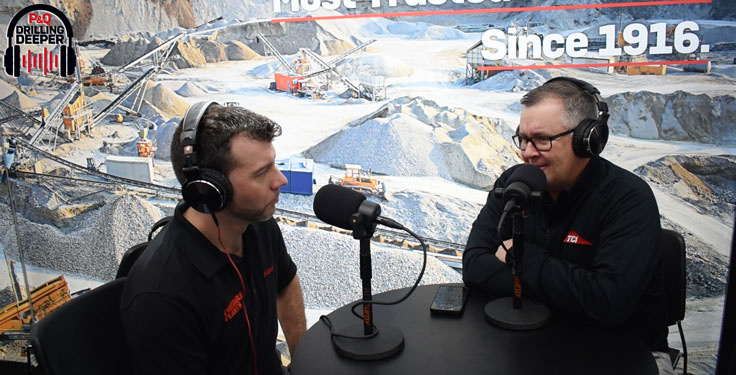Life in the fast lane
A NASCAR career is Greg Biffle’s No. 1 work-related commitment, but the driver with 19 career victories is also at home in the mine.
NASCAR driver Greg Biffle’s journey into aggregates stems from his very own crushing and screening equipment.
Greg Biffle is the first to admit that playing with toys is still a priority in his life despite juggling a busy racing schedule, time with his wife and daughter, a foundation for animals and a family business. But Biffle, a 44-year-old NASCAR driver, is not playing in the sandbox anymore. His toys have evolved from Tonka trucks to heavy-duty construction and aggregate equipment – and the bigger, the better, he says.
Biffle grew up loving anything with a motor and wheels. But it wasn’t until he started purchasing property in the southeastern United States that he thought about running equipment himself. His affinity for iron grew quickly.
Biffle started with a dozer, but his affinity soon developed into a considerable spread of crushing and screening equipment, which he used to landscape his 1,000-acre ranch in the mountains of North Carolina and his lake home.
“He’s like a little kid with Tonka toys,” says Jeff Biffle, Greg’s brother. “Now, he just does it with real equipment.”
In 2004, Greg began to work with a local company to build the shoreline of his manmade pond using natural river rock. But when the economy collapsed in 2008, the company shut down its mine for good, leaving Greg without a means to finish his landscaping with the same beautiful natural stone he fell in love with several years earlier.
“It was ironic how things happened,” Greg says. “I mentioned to the guy I had done some excavating and dozer work on the property and that I needed some more river rock, and he said the mine that the rock came from was just sitting there idle with a current permit.
“I realized very quickly that river rock is very expensive – I was paying $1,800 per dump truck for the material – and [considering] the entrepreneur that I am, I thought, ‘I’ll just go take a trip up there to look at the mine.’”
The surface mine, located in Speedwell, Va., was slightly more than five acres with about 60 percent of the rock mined. Already armed with several pieces of mining equipment, Greg thought to himself, “I already have the equipment, I won’t even have to buy anything. This will be fun.”
“And that’s how naïve I was,” Greg says.
New business opportunity
After Greg purchased the permit and the land, he soon realized a market existed for the handsome natural stone that came from the mountains of North Carolina and Virginia. He reached out to Jeff, who previously worked in the structural steel industry, and hired him as vice president of operations to run Triple B Stone.
Greg and Jeff tried to use the equipment already owned, but they quickly discovered they could only dry screen the material in optimum conditions.
“The material would have to be virgin material and super dry, and even then we were having trouble blinding the screens,” Greg says.
Knowing they would have to invest in better equipment, Greg and Jeff met in 2010 with Leon Luadzers, regional sales manager of KPI-JCI and Astec Mobile Screens, during ConExpo-Con/Agg. There, they were introduced to the Astec Industries family of companies.
Because Greg was unable to get the material clean enough for landscaping, Luadzers suggested KPI-JCI and Astec Mobile Screens’ twin blade mill and RS1822PH portable triple-deck screen as a way to prep the material.
“One of the problems Greg encountered early on was the need to wash the material twice, which added a lot of processing cost and time,” Luadzers says. “There is a rule of thumb in processing that says you add at least 50 cents per ton each time you handle raw material.
“We agreed that the best solution would be the 36-in. x 19-ft. twin blade mill, which would pre-condition the minus-[1.75]-in. gravel and sand before sending the material to a new, larger wash screen,” Luadzers adds. “The blade mill would break up soluble mud and clays through its combination of double-pitch spirals and paddles, which agitate the gravel and sand. This function was critical in producing an end product free of mud and clay balls.”
The twin blade mill was followed by a KPI-JCI RS1822PH portable plant, which consists of a 6-ft. x 16-ft. triple-deck horizontal vibrating screen with spray pipes on all three decks. This plant produces four washed products, including 1.75-in. x 0.75-in., 0.75-in. x 0.5-in. pea gravel and sand. A KPI-JCI 36-in. twin sand prep sand screw is mounted below the screen to clean and dewater the sand.
“Once we did that – once we conceded that it was the only way we’d be able to do this operation – that’s when our success came,” Greg says.
Lifelong learner
Greg admits it’s been a journey full of trial and error to get Triple B Stone to the point where it is today. Now, the company has 20 acres permitted to mine, and it hoped to sell 30,000 to 50,000 tons of material in 2013.
Greg points to his early start working for his parents’ steel business in Washington state as a pre-teen as the main reason he has his entrepreneurial spirit.
“I wasn’t handed anything,” he says. “Shoot, as a kid, I worked for my parents and saved my money so I could buy my first motorcycle. I really took to that mindset – that hard work and dedication would get you what you wanted.”
While Greg laughingly acknowledges it may have been easier to simply mine his own river rock and quit the business, anyone who follows NASCAR knows he is anything but a quitter.
“Nobody wants to lose. Nobody wants to be defeated,” Greg says. “Once I had my mind set to it, I decided I was going to make this process work. I wasn’t going to throw in the towel. And that probably hurt me a little bit – how stubborn I am. But today, it’s helped me create new ventures.”
That same determination that drives Greg to racing wins also helped him flourish in an industry he knew little about. With Jeff managing day-to-day operations, Greg is confident they’ve mastered the process and are set up to be successful.
“The operation is running like a Swiss watch,” he says. “We are very busy producing material and our sales are strong right now. Things are running really, really smoothly.”
Although Greg is not physically on location each day, he visits the site at least once a month, and when he’s on the road he’s found a way to stay in tune with daily operations.
“I put cameras up at the mine so I can see on my laptop or my phone whether the machines are running or not,” Greg says. “And really, it’s only for my pleasure. I take a lot of pride in it. We worked really hard on it, and I like to be able to see it. I may not be able to be there every day, but this way I get to experience a little part of it.”
Take note
Greg Biffle originally used his crushing and screening equipment to help landscape a 1,000-acre North Carolina ranch.









